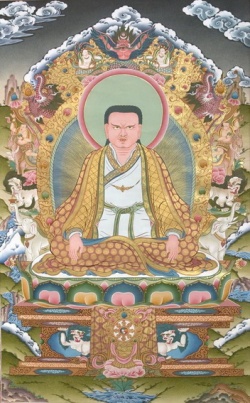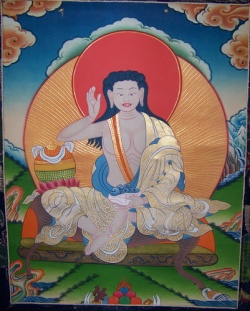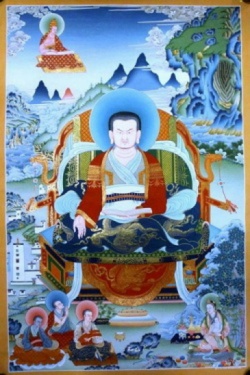Mila and Marpa
Biography and autobiography in Tibet are important sources for both education and inspiration. Tibetans have kept such meticulous records of their teachers that thousands of names are known and discussed in a wide range of biographical material. All these names, all these lives—it can be a little overwhelming. The authors involved in the Treasury of Lives are currently mining the primary sources to provide English-language biographies of every known religious teacher from Tibet and the Himalaya, all of which are organized for easy searching and browsing. Every Tuesday on the Tricycle blog, we will highlight and reflect on important, interesting, eccentric, surprising and beautiful stories found within this rich literary tradition.
Kagyu Founders: Mila and Marpa
The Kagyu tradition of Tibetan Buddhism is one of the major "new translation" traditions that began with the second propagation of Indian Buddhism to Tibet in beginning in the eleventh century. The Kagyu tradition—more specifically the Marpa Kagyu, as distinct from the Shangpa Kagyu—that stemmed from Marpa Lotsawa (c.1012-1097) and his disciple Milarepa (1040-1123), twice branched into separate traditions; first four, and then eight. Over the next few months we will periodically feature the biographies of Kagyu founders of these multiple traditions, beginning here with the two men, master and disciple, who started the whole thing in Tibet: Marpa and Milarepa.
Marpa Lotsawa Chokyi Lodro was born in the Lhodrak region of southern Tibet, the youngest of four brothers. An unruly youth, his father sent him away at the age of fifteen to study with the famous translator Drokmi Lotsawa (c.992-c.1072), the man who brought the Lamdre, later the central teaching of the Sakya tradition, to Tibet. Unable to afford Drokmi's infamously high fees, he left after three years to join a group of Tibetans going south to Nepal. Dharma translation was a lucrative profession in those days, and scores of people were going back and forth to bring new doctrines and new systems of Buddhist doctrine and practice back to Tibet.
This was the first of three trips Marpa is said to have made, during which he first met two Nepalese teachers and ultimately their master Naropa, the famous Bengali scholar who had by that point abandoned Nalanda monastic university for a forest retreat. After twelve years, he returned to Tibet with the Hevajra and Guhyasamaja Tantras, as well as the teachings of Mahamudra and the Six Yogas of Naropa. Back in Lhodrak his fame as a teacher grew, and he acquired both wealth and a household. Nevertheless, he returned to India twice more to train further with Naropa. It should be mentioned that Sakya polemicists, relying on what seems to be shaky history, later attempted to undermine Marpa's authority by arguing that he never actually met with Naropa.
Marpa is said to have had nine wives, one of whom was named Dakmema, who gave birth to Marpa’s son Darma Dode (dar ma mdo sde). The death of Darma Dode is one of the defining legends of the practice of ejecting consciousness, or powa, that Marpa brought back from India. According to legend, Darma Dode was murdered by rival translator Ra Lotsawa Dorje Drak. At the moment of his death he ejected his consciousness into the body of a pigeon, flew to India, and took possession of an Indian youth who grew into a Buddhist teacher named Tipupa, who went on to become a teacher of powa.
Marpa's most famous disciple was Milarepa, whom he put through a grueling series of tasks designed to purify him of his tremendous burden of sin. Milarepa, probably the one man out of Tibetan history known best in the West, is one of Tibet's best-loved saints. His biography is a model for all who traverse the Buddhist path, in that he was a mass murderer—he killed his extended family in revenge for poor treatment—who nevertheless, through tremendous exertion in practice, attained enlightenment in a single lifetime.
Milarepa had arrived at Marpa's door after a short but destructive career in black magic (and, according to early Kagyu partisans, a stint practicing Dzogchen, the central teaching of the Nyingma tradition, which didn't work for him). Following the grueling ordeals, which included repeatedly building and dismantling a nine-story stone tower, Marpa transmitted to Milarepa the teachings he had collected in India, chief among them the Mahamudra and the practice of tummo, or yogic heat, one of the Six Yogas of Naropa.
Milarepa spent the rest of his life in retreat high in the mountains of Tibet and Nepal, sitting year after year in caves across the central Himalayan range. His impact on the religious landscape of Tibet was second only to Padmasambhava; he subjugated local deities, opened new valleys and mountains for Buddhist practice, and empowered caves and hermitages that continue to draw pilgrims from across the Tibetan Plateau. Milarepa taught primarily through the medium of spontaneous song, many of which were remembered by his disciples and eventually collected and written down, forming the text known in English as the Hundred Thousand Songs of Milarepa. These songs, which, like the classic biography of Milarepa by Tsangnyon Heruka (1452-1507), who also compiled the songs, are finely crafted reflections on the sorrows of samsara and the necessity of traversing the Buddhist path as it was taught in the Kagyu tradition.


